Central Texas Rescuers Work to Save Pigs, Farm Animals During Winter Storm
By Benton Graham
Reporting Texas

One of 228 pigs living at the Central Texas Pig Rescue sniffs the finger of Shanda Harris, one of the rescue’s managing partners, on April 1, 2021. She and the other partners stayed at the shelter during the recent Texas freeze to keep animals alive. Thomas Fitch/Reporting Texas
The three managing partners at Central Texas Pig Rescue settled into a morbid routine during Winter Storm Uri in February. They started each day with a headcount to make sure all 228 pigs had survived the night. Once that was settled, they went about breaking up the containers of water that had frozen overnight.
“We were asking ourselves questions that we’ve literally never had to ask ourselves before because it’s just been so unprecedented,” said Tracey Stabile, one of the rescue’s managing partners. “It became questions of survival.”
All animals at the rescue, which includes the 228 pigs, four donkeys, two goats, five cats, six chickens and two guinea fowls, survived the storm.
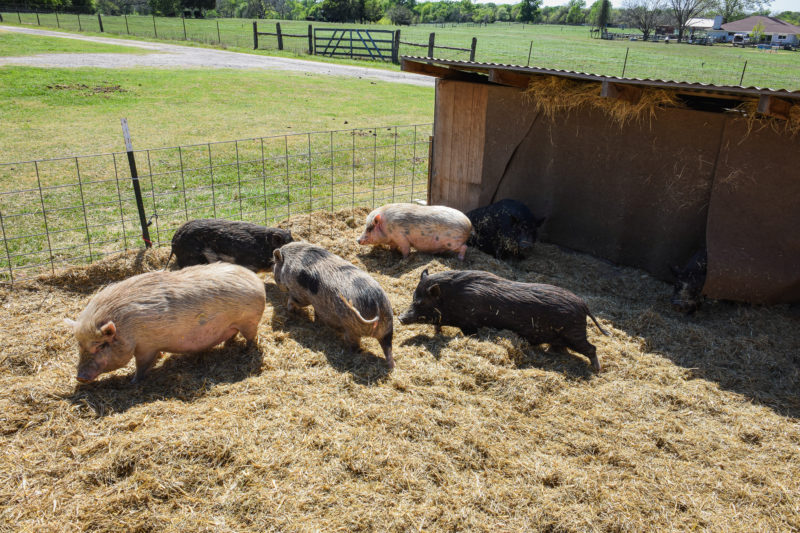
A group of pigs play in a pen at the Central Texas Pig Rescue in Bastrop, Texas, on April 1, 2021. All 228 pigs and animals at the site survived the recent freeze because volunteers took preventive actions to protect them. Thomas Fitch/Reporting Texas
Central Texas Pig Rescue, a non-profit, was founded in 2016 and is run entirely by volunteers. In addition to housing hundreds of pigs at its farm in Bastrop, the rescue sees itself as a pig advocacy group and aims to create the “perfect pig paradise.” As a part of their advocacy work, the rescue aims to shift public perception beyond seeing pigs as simply a meal, commodity, “micro pig” pet or an animal to test new products on. They also provide free support for pig parents.
In its first year, it took in 44 pigs as a part of a cruelty seizure from a breeder in Bastrop. The seizures typically involve animal control learning of a breeder keeping its pigs in poor living conditions. Once animal control seizes the pigs, if it can’t find them a new home in seven to 10 days, it often euthanizes the animals, Stabile said. The organization brought in another 133 pigs as a part of a separate cruelty seizure in Lockhart. According to the website, all of its pigs are rescued from “abuse, abandonment, neglect, slaughter, and animal testing.”
Stabile, who has been with the rescue for five years, and the two other managing partners stayed at the farm throughout the storm. They didn’t lose power nor water, but the cold presented other challenges.
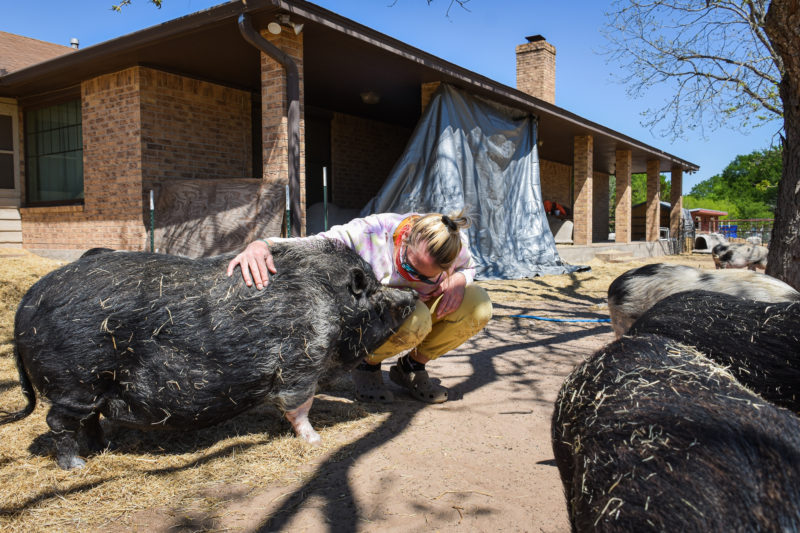
Shanda Harris, one of three managing partners of Central Texas Pig Rescue, leans in to kiss a pig on April 1, 2021. She and the other rescue partners used tarps as wind breaks during the recent freeze to protect the animals from the cold. Thomas Fitch/Reporting Texas
Most of the barns at the rescue are built for summer and aren’t insulated. That meant the rescue needed to find hay to keep the pigs warm. Typically, they buy 15 square bales of hay per week, but the week prior to the storm they bought 70. They also wrapped some of the barns with tarps as a makeshift windbreak. The hay served a dual purpose, because the pigs could eat it in their barns.
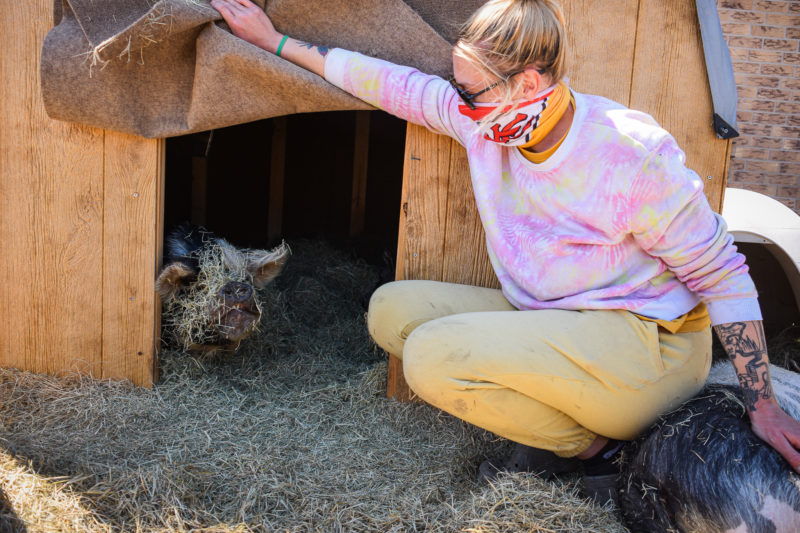
Shanda Harris pulls back the door of a barn to reveal a hiding pig at the Central Texas Pig Rescue on April 1, 2021. During the freeze, volunteers had to find ways to house the pigs that sometimes didn’t want to sleep near other pigs. Thomas Fitch/Reporting Texas
Finding sufficient housing proved to be another challenge, as some pigs sleep outside to keep their distance from rival pigs. The rescue has enough barn space for all of its pigs to sleep inside, but “pig politics” created a logistical headache.
“The politics of it is extremely complex,” Stabile said. “There are certain pigs that won’t go into the barns that a different pig is sleeping in, because they just don’t get along.” Some of the older pigs slept in the house, but the rescue still needed another barn. They called their supplier, Sturdi-Bilt, and were able to have a new barn installed the next day.
Alex Ramirez, a pig veterinarian at Iowa State University, said that while pigs tend to be more tolerant of cold than hot weather, wind and wetness can put the animals in a dangerous situation. The ideal temperature for an adult sow is somewhere between 55 and 65 degrees Fahrenheit, but they can be comfortable at temperatures outside of that range, he added. With high wind, snow and temperatures dipping into the single digits, the storm put the pigs in a dangerous environment.

Two pigs run up to Shanda Harris at the Central Texas Pig Rescue in Bastrop, Texas, on April 1, 2021. Thomas Fitch/Reporting Texas
Ramirez validated many of the rescue’s tactics, saying that outdoor pigs need to be insulated from the cold with hay or bedding to protect them from those types of weather conditions. “You can actually put quite a bit of layers, so the pigs can actually dig themselves into the hay,” he said.

Three dogs look into one of the pigpens at the Central Texas Pig Rescue on April 1, 2021. All animals housed at the shelter survived the recent Texas freeze because of actions taken by volunteers. Thomas Fitch/Reporting Texas
Maintaining access to water is also important to the pigs’ survival. “A day or two without water, it’s kind of like us. They get thirsty and start feeling a little different, but it’s not the end of the world,” Ramirez said. “But … when we start getting into four days, five days, we can actually cause what’s called salt toxicity, and it can be deadly.”
Many other farm animal operations faced significant challenges during the winter storm. Mary Ann Fordyce has been running Blue Star Ranch for 14 years. The farm primarily sells pet chickens and chicks and helps local schools hatch eggs. While the ranch didn’t lose power, it lost water for about three days.
Fordyce had prepared for the storm by setting up a swimming pool filled with water, but that plan hit a snag. “Within a matter of hours, their water would freeze over so I can only give them several cups at a time,” she said.
Throughout the storm, her routine consisted of walking the 10 to 12 feet from her house to the barn with water for the chickens. Like Stabile, she would then spend time breaking up any ice in the water containers. “It was not pleasant at all to have to go out there with a hammer and smash a plastic pool and hope that there was enough water to give them when I ran out of water,” Fordyce said
While the farm did lose a few chickens, Fordyce is grateful so few died. She heard horror stories of farms losing hundreds of chickens. “We always expect the worst. When you’re raising chickens you hope for the best but plan for the worst,” she said.
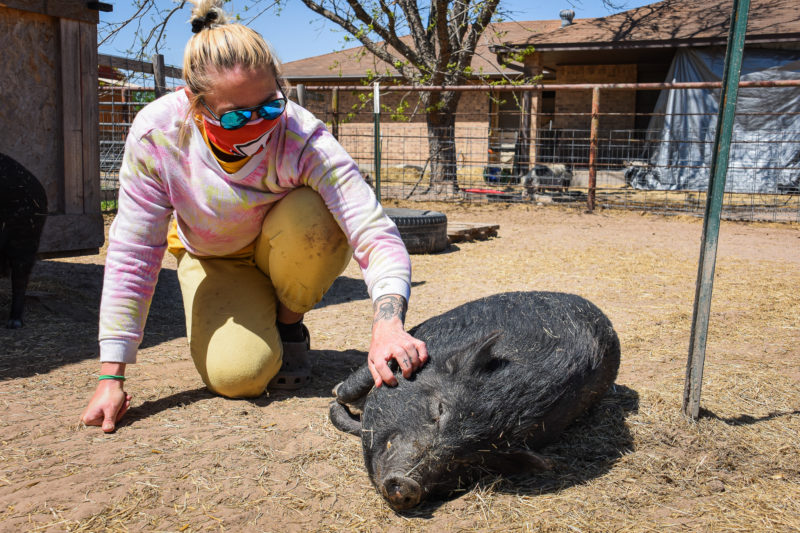
One of the rescue pigs enjoys a scratch from Shanda Harris at the Central Texas Pig Rescue on April 1, 2021. Thomas Fitch/Reporting Texas
Meghan Ekno, a case manager with the Texas Attorney General’s Office, began volunteering with the rescue in July 2020. Like so many others, she was looking for an excuse to get outside during the pandemic, and she thought back to how much she had enjoyed the pigs at a holiday event in 2019.
The Saturday before the storm, Ekno was driving to the rescue in Bastrop to scoop the pigs poop, a typical task for volunteers. Before making it out of Austin, her white Subaru Forester hit a patch of ice and slid into a barrier.
“I was initially thinking, ‘Can I fix this?’ And then I realized that that’s not going to happen, and I saw the barrier coming towards me,” Ekno said. The crash totaled her car, and she didn’t make it to the rescue that day. Her next visit came one week later, when she went for a shower because her place had lost water.
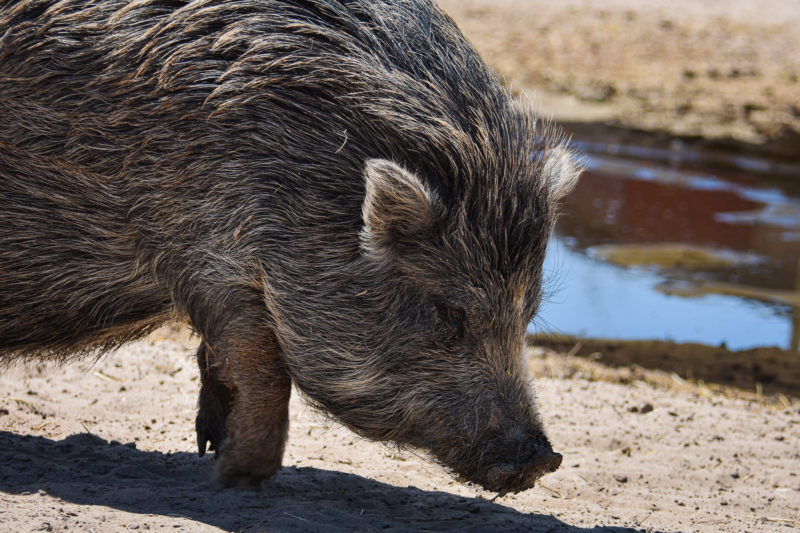
Pigs wander around the pens at the Central Texas Pig Preserve in Bastrop, Texas. Many are rescued from breeders that keep them in poor living conditions. Thomas Fitch/Reporting Texas
Stabile is tremendously grateful for the way the community rallied around the rescue.
“The outpouring of support came from people who didn’t know how bad it was going to get for them,” she said. “That’s something that’s really sobering that everybody was very focused on our survival and the well being of the pigs.”